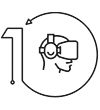The travel and tourism1 sector is booming; it saw more growth in 2018 than all other economic sectors aside from manufacturing, and accounted for 10.4 percent of the world’s Gross Domestic Product (GDP).
The industry has had to deal with a backdrop of political conflict, huge natural disasters and financial troubles. Despite this, The World travel & Tourism Council (WTTC) president Gloria Guevara said that the sector was responsible for creating a fifth of all new jobs worldwide, and the council believes that the industry will produce 100 million new jobs worldwide over the next 10 years. Many of the companies that were struggling in this sector have moved swiftly to embrace emerging technologies.
Let’s take a look at the top technology trends that are causing disruption in the travel industry, and are likely to have significant impact on business outcomes.
Case Study
Transforming Operations for a Leading Australia-based Tour Operator
Read More

Enhancing Passenger Experience with Augmented Reality & Virtual Reality
Several airlines have either tested or are currently testing Virtual Reality (VR) as part of their in-flight entertainment offerings. In a fiercely competitive market, these airlines will be hoping that a more immersive entertainment experience, which includes VR games, movies and experiences, will help attract more customers.
The technology is also being used as a cabin crew training tool and a way for passengers to experience the plane before boarding. Japanese company First Airlines3 has even created the first ever VR airline hub, which enables people to put on a VR headset and imagine they’re on a flight – with in-flight meals, announcements and sounds to mimic those on an actual flight. They can then also experience a 360-degree virtual city tour on ‘arrival’ at either Paris, New York, Rome or Hawaii.
Meanwhile, Augmented Reality (AR) has been used to help passengers ensure that their hand luggage is the correct size before they leave their houses, and for the cabin crew to swiftly access information about a passengers’ destination or allergies while onboard a flight. travel organizations will be able to use more and more data to influence how VR and AR is used in the future – perhaps tailoring advertisements or content to specific customers.

Making Security Seamless with Artificial Intelligence
Artificial Intelligence (AI) has been used for a number of years to improve customer experience, with one of the most common uses being chatbots that utilize machine learning to resolve queries quickly.
But AI is now becoming more sophisticated and integrating into other technologies too. A report from the U.S. Department of Homeland Security4 states that in the next four years, its airports will be leveraging AI to scan 97 percent of the passengers’ faces.
The U.K. government has invested GBP 1.8 Million5 in AI technologies to boost security and reduce wait times at its airports. One of the AI systems can identify suspicious objects in footwear and hence saves passengers the inconvenience of removing their shoes during security check. Another AI project involves detecting the natural radiation of passengers, converting the data into images and assessing whether they have harmful devices on them.
Personalized content for in-flight entertainment and fully AI-powered airports where passengers can seamlessly walk through security without putting down their bags could become a norm in the future.

Personalizing Passenger Journeys with Wearables & IoT
Wearables are enabling customers to get updates about their flight and use a boarding pass on many journeys without the hassle of scrolling through their phones. Tourism companies are using wearables more extensively than other players in the travel ecosystem. Disney’s MagicBand6 which gives customers access to its parks and replaces almost all transactions inside is one example of how wearables are emerging as a technology to invest in.
Hotels are leveraging Internet of Things (IoT)-enabled sensors to adjust the heat and air conditioning as per customers’ liking. At some airports, bags are tagged with IoT sensors to alert passengers while their luggage is on the baggage carousel, or give passengers the opportunity to track them via mobile apps.
Airlines could attach IoT sensors to the seats to measure the heart rate and body temperatures of passengers. This can help the cabin crew assist passengers who need water or re-assurance. Wearables can alert passengers to move around on long-haul flights to avoid deep vein thrombosis.

Automating Actions with Voice & Robotics
Voice technology and robotics are already disrupting the travel industry. Voice-activated devices in hotel rooms enable guests to check on traffic and weather conditions, or restaurant recommendations. At the Wynn hotel in Las Vegas, guests can call on Amazon’s Alexa to close the drapes and turn on the lights.
Some hotels already have AI robots helping guests check in without the need to speak to a human. A global hotel chain7 leverages an AI-powered concierge with speech recognition capabilities to help guests with their enquiries. A few new hotels are using robots for room service as well.
Airports have been experimenting with different types of robots. There are self-driving trolleys for luggage, robot cleaners, and robots geared for answering passenger queries about flight times and departure gates.

Hassle-free Experiences with Biometric
Technology
Facial recognition and fingerprints have already been used for a number of years for security purposes at airports. The technology could make its way to hotels, enabling guests to walk through the hotel and into their room without the need to check in and use a key card. Instead, if the guest’s face matches the ID they’ve already given to the hotel, scanners throughout the hotel can authorize them to enter buildings and rooms.
In addition, biometric technology could enable hotels to keep better track of guests that want to charge items to their rooms as it would require a thumb scan rather than a signature and room number. The experience could be made even more seamless for customers if they can enter a hotel restaurant and leave, with the bill charged to the room through facial recognition – similar to the quick experience customers get in retail with Amazon Go.8
All of these emerging technologies are exciting for business leaders. However, these technologies need to be integrated with the right data platforms and analytics capabilities to truly benefit the business. For instance, hotels would be able to know if a customer will visit again from the data stored from facial recognition, and an airline can tell if a VR or AR experience was enjoyable to the customer so that it can improve the service if necessary. Without the right platforms, these technologies will merely end up as a fad.
These technology advancements are particularly transformative when aligned with current airline trends that are reshaping passenger experiences and operational models throughout the aviation sector.
Click here to view the infographic